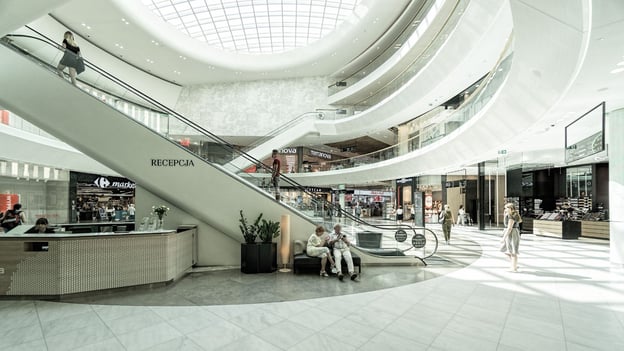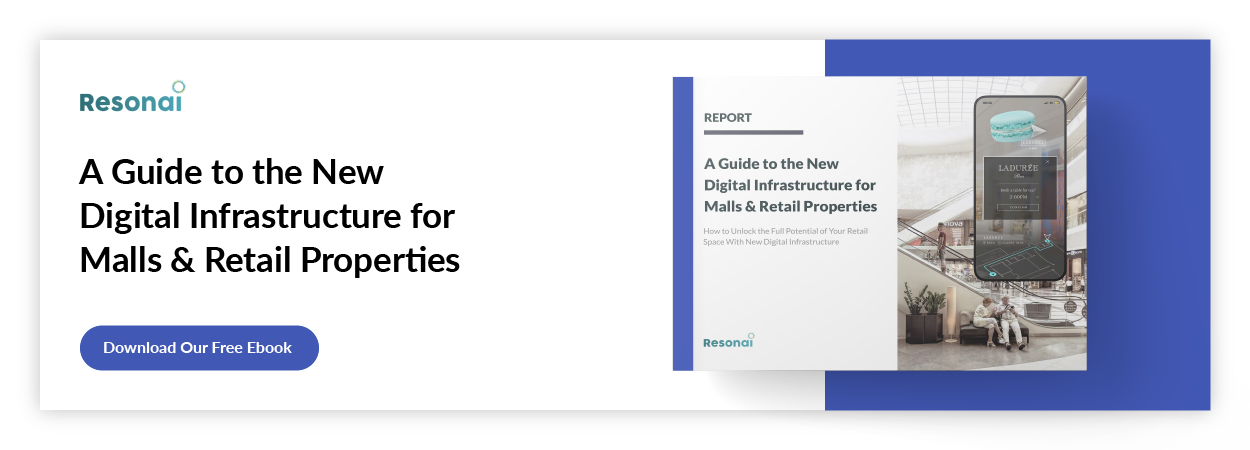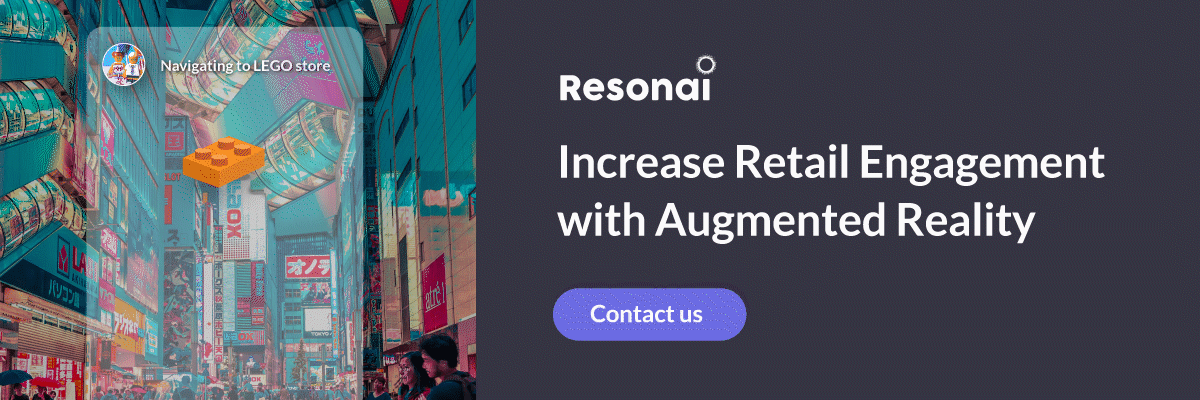What Is Shopping Center Architecture and How Does it Affect the Customer Experience?
Thoughtful design can improve customer mood, increase time spent within the shopping center, and more

In-person shopping is far from dead — in fact, the largest mall owner in the U.S. reported retail occupancy rates at nearly 95%, within spitting distance of pre-pandemic numbers. To keep shopping center traffic growing in the face of the convenience offered by online retail, brick-and-mortar shopping centers must put an increased effort into designing physical spaces people want to visit and linger at. Read on to learn more about shopping center architecture and how it can affect the customer experience to keep visitors coming back again and again.
Jump to a section…
What is shopping center architecture and design?
How does shopping mall architecture design impact the customer experience?
Visibility and accessibility of retail stores
How can technology improve shopping center architecture design?
Expand your knowledge of shopping mall design and best practices with The Planner’s Guide to Mall Design.
What is shopping center architecture and design?
Shopping center architecture and design is the practice of creating retail spaces to improve the consumer experience, from arrival to departure and everything in between. Planners must take a holistic approach when crafting shopping center designs, as a single poor experience can negatively impact a visit, reducing overall satisfaction and potential profits. Elements such as the layout and traffic flow of interior shopping and exterior parking areas, the placement of amenities, and even decor can affect consumer mood and influence shopping behaviors.
Creating and iterating on quality shopping mall design architecture requires keen insight into consumer behavior. Implementing digital infrastructure, such as augmented reality (AR), can provide a window into that insight by capturing live consumer data and tracking shopping trends. Download our free ebook today to learn how AR unlocks next-level consumer data analysis allowing you to maximize income per square foot while providing memorable, immersive shopping experiences for guests.
How does shopping mall architecture design impact the customer experience?
A thoughtful approach to shopping mall architecture and design can mean the difference between a well-trafficked, high-value retail space and abandonment by both businesses and shoppers. Here are just a few ways your approach to architecture can impact shopper behavior — and your bottom line.
Influence customer mood
A consumer’s state of mind can greatly influence what and how much they purchase. While you can’t necessarily predict what state of mind customers will be in when they arrive at your shopping center, your architecture can influence how they feel while they are there.
Influencing customer mood begins before they even set foot in your shopping center. Positive experiences in the parking lot — both in availability and safety — are directly linked to customer satisfaction and retention. Ensure that your center has ample parking for all its major entryways and that navigation into and out of the parking lot is smooth and hassle-free.
Once inside, sensory elements such as lighting, sounds, foliage, and smells can impact the consumer’s emotional state. Consider the potential difference in mood generated by artificial and natural lighting or narrow, cramped corridors and open-air design. A bright, vibrant, and organized environment is more conducive to a positive experience. Monitoring and improving foot traffic congestion, offering ample access to amenities like restrooms and lounge areas, and displaying clear signage for navigation will also provide a positive shopping experience for visitors.
Increased shopping times
When it comes to convenience, nothing will beat online shopping, so shopping centers need to be more creative in finding ways to get shoppers through the door — and, more importantly, get them to stick around.
Experts say that the goal of modern shopping mall architecture is to get guests to stay as long as possible. Shopping center owners can achieve this through several tactics, including:
- Brand mix/clustering: Finding the right mix of tenants and clustering them by department makes shopping more convenient and encourages consumers to move through the entire mall to access different retail groups.
- Well-spaced lounge areas: Providing designated areas for meeting and relaxing incentivizes customers to take their time as they shop, reducing fatigue and stress. Adding charging stations can further reduce stress, as guests will no longer have to worry about their smartphones mid-trip.
- Event spaces: Shopping centers can be for more than retail — they can provide a venue for concerts, gatherings, and more. Plus, entertainment centers like movie theaters, arcades, bowling alleys, and VR attractions can act as a bridge to and from your center’s retail offerings.
- Dining plazas: Providing a variety of fast-food and casual dining experiences incentivizes customers to plan their day around their visit to your shopping center.
Visibility and accessibility of retail stores
Shopping center architecture can also impact retail stores housed within. Building architecture should work to make all storefronts within the shopping center as easy to find and accessible as possible. Planners should pair stairs with elevators and other accessible pathways. Anchor stores should be given equal weight within the design layout to ensure surrounding retail businesses don’t get lost in the shuffle. Making retail businesses as visible and accessible as possible will ensure you maximize your shopping center's dollar value per square foot without creating any potentially customer-neglected areas.
How can technology improve shopping center architecture design?
To enhance your approach to shopping center architecture and design, implement technological solutions to provide positive shopping experiences while generating actionable data. For example, digital signage can easily swap between interactive kiosks for navigation and additional advertising space, providing novel ways to convey critical information to guests. Many of these signs also come embedded with hardware designed for tracking customer use, so you can determine which elements are making the most impact over time.
Of course, augmented reality continues to shape and redefine how customers interact with physical spaces — and retail is no exception. AR is a valuable tool for improving customer interest in retail, especially as over 60% of shoppers prefer to shop where AR experiences are available. Popular AR experiences include interactive mirrors to allow guests to virtually try on an assortment of fashion items or digital twins that provide guided experiences and additional data through mobile apps.
AR can also help your business gather and analyze customer data. This info can help you define the customer journey through your shopping center, determine choke points in high-volume foot traffic, or see which businesses are underperforming compared to their neighbors. Then, you can utilize this information to adjust shopping center architecture or design to further improve the customer experience.
Download our free ebook to discover how the next generation of digital infrastructure can improve your approach to architecture and design and unlock additional revenue streams. And if you’re ready to learn more, get in touch with the experts at Resonai today.
Subscribe to Our Newsletter!
Read More
5 Mall Design Best Practices That Drive Tenant Satisfaction
Mall owners want each stall of their facility to be filled with a tenant, keeping customers flowing...
5 Considerations for a Small Shopping Center Design
Retail has rebounded significantly since the beginning of the COVID-19 pandemic. Occupancy rates...
7 Shopping Mall Floor Plan Resources and Design Tips to Give Your Layout a Boost
The shopping mall experience has undergone significant change in the past few years, and after two...

